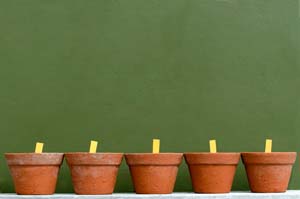Ask Mr. Sage: How Should I Space Salvias When Planting

Dear Mr. Sage,
I just placed an order for a number of different Salvias. How far apart should I plant them?
Thank you,
Confused in Carmel
Dear Confused in Carmel,
I notice that your order includes four pots of Greek Sage (Salvia fruticosa), each of which can grow to approximately 18 inches wide. Let's start by exploring how to space these sages.
This sage is a perennial, which means that its soft herbaceous growth dies to the ground in winter. Other culinary sages include subshrubs, which combine soft herbaceous foliage with woody growth and may also die to ground during chilly weather. Whether shrubs, subshrubs or perennials, Salvias that are evergreen or are reborn each spring require careful spacing or they become overcrowded in a few years.
Most Salvias are healthier with good air circulation. Crowding causes fungal diseases to spread and also makes it easier for pests, such as spider mites, to travel from one plant to another. In addition, crowding cramps and distorts growth.
Conversely, if spacing is extremely wide, other problems can occur such as branches being buffeted and broken by high winds. Grouping plants and spacing them correctly can protect them against wind damage.
The rule I follow is to space each plant based on its maximum, or mature, width. Greek Sage spreads to about 18 inches wide. When massing a group of it, I would space the plantings to provide 18 to 24 inches of open space around each one. Plant them 18 inches apart if you need to achieve a denser look when they are fully-grown; choose 24 inches if you want an airier grouping.
But let's say that you are interspersing multiple plantings of this sage with another species that has a wider circumference. Suppose that the second species is Lipstick Autumn Sage (S. greggii ''Lipstick') that you've ordered and which spreads about 36 inches wide.
Think of the culinary sage as Plant A and Lipstick Red as Plant B. If you group them in an "ABAB" pattern with Lipstick Red exactly halfway between two of the culinary sage plants, then the minimum spacing from one Plant A to another Plant A (with a Plant B halfway between) would be 18 plus 36 inches, or 54 inches.
Please excuse me if this is beginning to sound a bit like one of those dreaded word problems from elementary school. However, my point is that to allow your Salvia garden to breathe easy as it grows, you need to start by doing your addition when spacing and considering the aeration of all plants in the mix.
Gardeners often are tempted to group plants too closely in order to make a flowerbed look full and lush as quickly as possible. Yet this eventually results in problems that require replanting and extra pruning to create healthier, more attractive growth.
A more practical way to create a well-massed appearance when growing perennial and shrubby sages is to fill in the empty space between them -- for a season or so -- with small annuals, such as Burgundy Scarlet Sage (S. splendens 'Burgundy'), Peach Scarlet Sage (S. splendens van houttei 'Peach'), California Poppy (Eschscholzia californica) and Calendulas.
By adding annuals to the mix, you provide groundcover that minimizes weeds. The number of seasons that you will need to fill in with annuals depends on whether you've planted fast- or slow-growing sages and on local climate considerations, including how long your growing season lasts.
Climate affects how rapidly plants grow. A border of perennial or shrubby Salvias grows far more quickly in a moderately warm, extremely plant-friendly climate along the Pacific Coast, such as in Carmel. In the shorter season of a Zone 5 area, growth takes longer.
If you have more questions or concerns, please contact us at Flowers by the Sea. We'd also love to hear from you and see photos of your plantings as they mature.
Always Glad to Help,
Mr. Sage

 Salvia splendens van houttei 'Burgundy'
Salvia splendens van houttei 'Burgundy'  Salvia greggii 'Lipstick'
Salvia greggii 'Lipstick'
Comments
There are no comments yet.